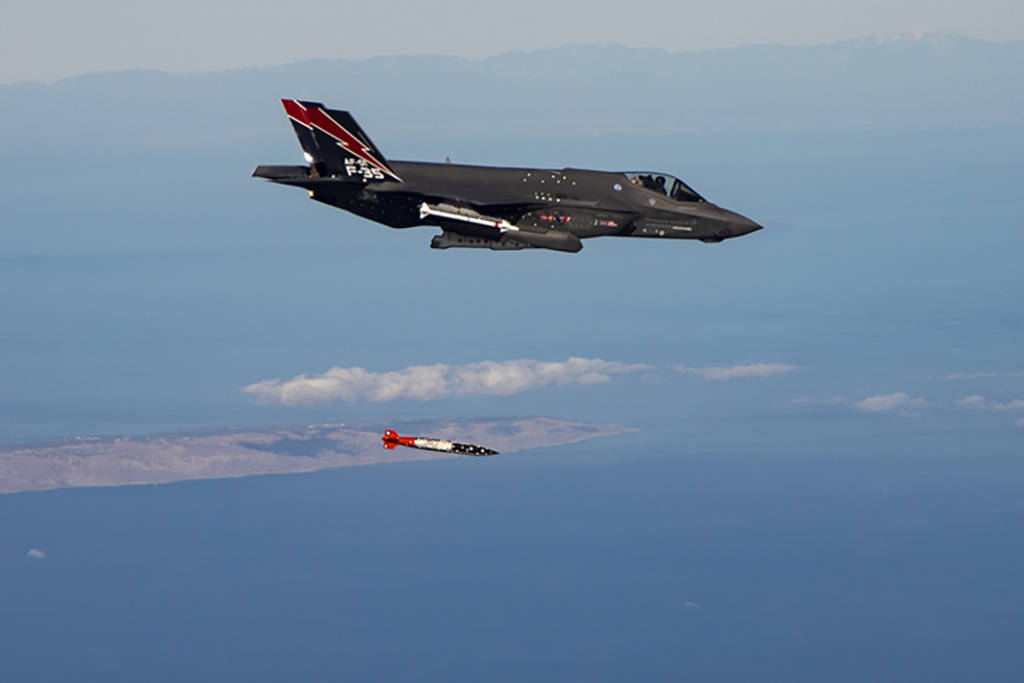The US has accelerated the delivery of the upgraded nuclear bombs to Europe amid escalating tensions with Russia, as per a US Diplomatic Cable cited by a recent Politico report.
According to the cable, the US officials told NATO allies during a closed-door meeting in Brussels this month that the upgraded B61-12 thermonuclear bomb that was initially scheduled to arrive in Europe next year could be deployed as early as December 2022.
This new and more accurate version of the B61-12 bombs will replace the older weapons in various NATO countries, including Belgium, the Netherlands, Italy, Germany, and Turkey.
Additionally, the Biden administration has added the UK to the list of countries that will store US nuclear weapons, as earlier reported by EurAsian Times.

The US Air Force (USAF) used to store nuclear gravity bombs at RAF Lakenheath near the village of Lakenheath in Suffolk, England, UK, which in the 1990s had 33 underground storage vaults.
By the early 2000s, the vaults at Lakenheath had 110 B61 nuclear gravity bombs for delivery by F-15E aircraft of the 48th Fighter Wing of the USAF in Europe (USAFE).
In 2008, it was reported that nuclear weapons had been withdrawn from RAF Lakenheath. The US wants to return the weapons to those bunkers after 14 years of standing empty.
The weapons storage sites in Belgium, the Netherlands, Italy, Germany, Turkey, and the UK have undergone an infrastructure upgrade as part of a 13-year NATO investment program to store the new upgraded B61-12 bombs.
B61-12 Nuclear Air-Dropped Bombs
B61-12 is the latest variant of the B61 family of air-launched nuclear gravity bombs, which the US military has been operating since 1968.
The new variant, which is developed as part of the $10 billion B61-12 Life Extension Program, managed by the US Department of Energy, is aimed at enhancing the nuclear capabilities of the US and allied nations.
The bomb can be air-launched by the aircraft platforms such as B-2A, F-15E, F-16C/D, F-16 MLU, PA-200, F-35, and B-21.

In December 2021, the National Nuclear Security Administration (NNSA) announced that the first production unit of the B61-12 had been completed.
Full-scale manufacturing was expected to begin in May 2022, and production is to be completed sometime in 2026, according to the NNSA. The project is expected to cost $8.4 billion in total.
The B61-12 is based on the B61-4 warhead with the new tail kit guidance assembly, which combines the new guided freefall capability with the existing ballistic (unguided) delivery capability of the B61 bomb. Equipped with four maneuverable fins, the tail section offers high levels of accuracy and limited stand-off capability over the previous variants.
It has a length of 3.6 meters and weighs approximately 375 kilograms. It can be fired at the target in ballistic gravity or guided drop modes.

Notably, the missile is armed with one of the most versatile warheads in the US arsenal, as its explosive power can be moved up or down depending on the target, making it either a low- or medium-yield weapon.
Located in the bomb’s middle section, the warhead has four yield options, including 0.3kt, 1.5kt, 10kt, and 50kt.
The bomb uses an inertial navigation system (INS) to achieve high kill probability while improving the survivability of the launch platform. The weapon is expected to have an accuracy of approximately 30 meters.
US Speeding Up Delivery Of Nukes To Europe?
As reported by EurAsian Times, the USAF was scheduled to begin training the nuclear units in Europe within the next year to receive the new B61-12 guided nuclear bomb. The first B61-12 bombs were expected to be shipped to Europe in 2023.
However, the new timeline for arrival suggests the Pentagon has determined the weapon is ready earlier than planned, according to Hans Kristensen, the Director of the Nuclear Information Project at the Federation of American Scientists (FAS).
Kristensen said that the Defense Department (DoD) Inspector General was expected to complete a review of the weapon’s performance before the beginning of training for aircrews.
The USAF conducted flight tests of the new bomb design on the F-35A in October last year and certified it on the F-15E in 2020. However, the Pentagon said in February that it intended to “complete nuclear design certification of the B61-12 with the F-35A before January 2023, after which the [US Air Forces in Europe] will be able to start certification training,” noted Kristensen.
“I thought those two things were going to happen before you saw the physical arrival,” Kristensen continued.
Notably, the news of expedited delivery of these air-dropped nuclear bombs to Europe has come amid heightened tensions over Russia’s repeated threats to use a nuclear weapon in Ukraine, which has been a cause of concern for the West.
However, US officials have maintained that upgrading the B61 bombs and replacing old bombs in NATO-member countries with new ones ensures the stockpile is modernized and safe.
“Modernization of US B61 nuclear weapons has been underway for years, and plans to safely and responsibly swap out older weapons for the upgraded B61-12 versions is part of a long-planned and scheduled modernization effort. It is in no way linked to current events in Ukraine and was not sped up in any way,” Pentagon spokesman Brig. Gen. Patrick Ryder told Politico.
According to experts, the accelerated delivery in December may be directed more at European allies that feel particularly vulnerable to Russia’s aggression.
“My guess is it is aimed more towards NATO than Russia,” said Tom Collina, Director of Ploughshares Fund, a disarmament group. “There are [older] B61s already there. The Russians know that. They work just fine. The new ones will be newer, but it’s not that much of a difference. But it may be a way to assure the allies when they feel particularly threatened by Russia,” he said.
- Contact the author at tanmaykadam700@gmail.com
- Follow EurAsian Times on Google News




